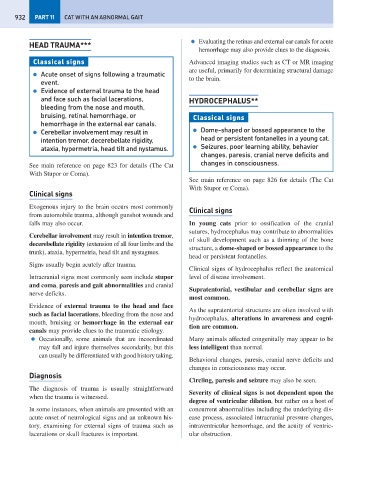Page 940 - Problem-Based Feline Medicine
P. 940
932 PART 11 CAT WITH AN ABNORMAL GAIT
● Evaluating the retinas and external ear canals for acute
HEAD TRAUMA***
hemorrhage may also provide clues to the diagnosis.
Classical signs Advanced imaging studies such as CT or MR imaging
are useful, primarily for determining structural damage
● Acute onset of signs following a traumatic
to the brain.
event.
● Evidence of external trauma to the head
and face such as facial lacerations, HYDROCEPHALUS**
bleeding from the nose and mouth,
bruising, retinal hemorrhage, or Classical signs
hemorrhage in the external ear canals.
● Cerebellar involvement may result in ● Dome-shaped or bossed appearance to the
intention tremor, decerebellate rigidity, head or persistent fontanelles in a young cat.
ataxia, hypermetria, head tilt and nystamus. ● Seizures, poor learning ability, behavior
changes, paresis, cranial nerve deficits and
changes in consciousness.
See main reference on page 823 for details (The Cat
With Stupor or Coma).
See main reference on page 826 for details (The Cat
With Stupor or Coma).
Clinical signs
Exogenous injury to the brain occurs most commonly
Clinical signs
from automobile trauma, although gunshot wounds and
falls may also occur. In young cats prior to ossification of the cranial
sutures, hydrocephalus may contribute to abnormalities
Cerebellar involvement may result in intention tremor,
of skull development such as a thinning of the bone
decerebellate rigidity (extension of all four limbs and the
structure, a dome-shaped or bossed appearance to the
trunk), ataxia, hypermetria, head tilt and nystagmus.
head or persistent fontanelles.
Signs usually begin acutely after trauma.
Clinical signs of hydrocephalus reflect the anatomical
Intracranial signs most commonly seen include stupor level of disease involvement.
and coma, paresis and gait abnormalities and cranial
Supratentorial, vestibular and cerebellar signs are
nerve deficits.
most common.
Evidence of external trauma to the head and face
As the supratentorial structures are often involved with
such as facial lacerations, bleeding from the nose and
hydrocephalus, alterations in awareness and cogni-
mouth, bruising or hemorrhage in the external ear
tion are common.
canals may provide clues to the traumatic etiology.
● Occasionally, some animals that are incoordinated Many animals affected congenitally may appear to be
may fall and injure themselves secondarily, but this less intelligent than normal.
can usually be differentiated with good history taking.
Behavioral changes, paresis, cranial nerve deficits and
changes in consciousness may occur.
Diagnosis
Circling, paresis and seizure may also be seen.
The diagnosis of trauma is usually straightforward
Severity of clinical signs is not dependent upon the
when the trauma is witnessed.
degree of ventricular dilation, but rather on a host of
In some instances, when animals are presented with an concurrent abnormalities including the underlying dis-
acute onset of neurological signs and an unknown his- ease process, associated intracranial pressure changes,
tory, examining for external signs of trauma such as intraventricular hemorrhage, and the acuity of ventric-
lacerations or skull fractures is important. ular obstruction.

